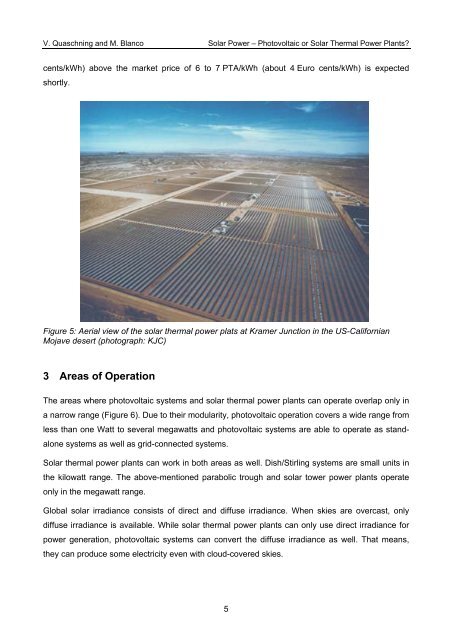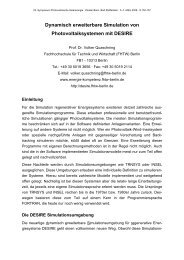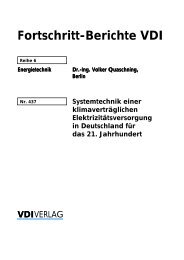Photovoltaics or Solar Thermal Power Plants? - Volker Quaschning
Photovoltaics or Solar Thermal Power Plants? - Volker Quaschning
Photovoltaics or Solar Thermal Power Plants? - Volker Quaschning
Create successful ePaper yourself
Turn your PDF publications into a flip-book with our unique Google optimized e-Paper software.
V. <strong>Quaschning</strong> and M. Blanco <strong>Solar</strong> <strong>Power</strong> – Photovoltaic <strong>or</strong> <strong>Solar</strong> <strong>Thermal</strong> <strong>Power</strong> <strong>Plants</strong>?cents/kWh) above the market price of 6 to 7 PTA/kWh (about 4 Euro cents/kWh) is expectedsh<strong>or</strong>tly.Figure 5: Aerial view of the solar thermal power plats at Kramer Junction in the US-Calif<strong>or</strong>nianMojave desert (photograph: KJC)3 Areas of OperationThe areas where photovoltaic systems and solar thermal power plants can operate overlap only ina narrow range (Figure 6). Due to their modularity, photovoltaic operation covers a wide range fromless than one Watt to several megawatts and photovoltaic systems are able to operate as standalonesystems as well as grid-connected systems.<strong>Solar</strong> thermal power plants can w<strong>or</strong>k in both areas as well. Dish/Stirling systems are small units inthe kilowatt range. The above-mentioned parabolic trough and solar tower power plants operateonly in the megawatt range.Global solar irradiance consists of direct and diffuse irradiance. When skies are overcast, onlydiffuse irradiance is available. While solar thermal power plants can only use direct irradiance f<strong>or</strong>power generation, photovoltaic systems can convert the diffuse irradiance as well. That means,they can produce some electricity even with cloud-covered skies.5









